5 Bold Moves: Counter Positioning that Redefined Industries

GET THE #1 EMAIL FOR EXECUTIVES
Subscribe to get the weekly email newsletter loved by 1000+ executives. It's FREE!

Middle of winter here. Olympics next week🏅🎉. The whole world shut down by a Microsoft outage on Friday night!
We are going to run through 5 examples of counter positioning in business.
- Netflix vs. Blockbuster
- Tesla vs. Traditional Auto Manufacturers
- Spotify vs. Traditional Music Industry
- Path of Exile vs. Diablo 3
- Amazon Web Services vs. Traditional IT Infrastructure
To be clear, here is what counter positioning is:
Counter positioning:
A strategy where a new entrant adopts a new, superior business model that the incumbent does not mimic due to anticipated damage to their existing business.
This approach allows the new entrant to capture market share and establish a strong position before the incumbent can react effectively.
Netflix vs. Blockbuster
The clash between Netflix and Blockbuster is a classic example of counter positioning that reshaped the entire home entertainment industry.
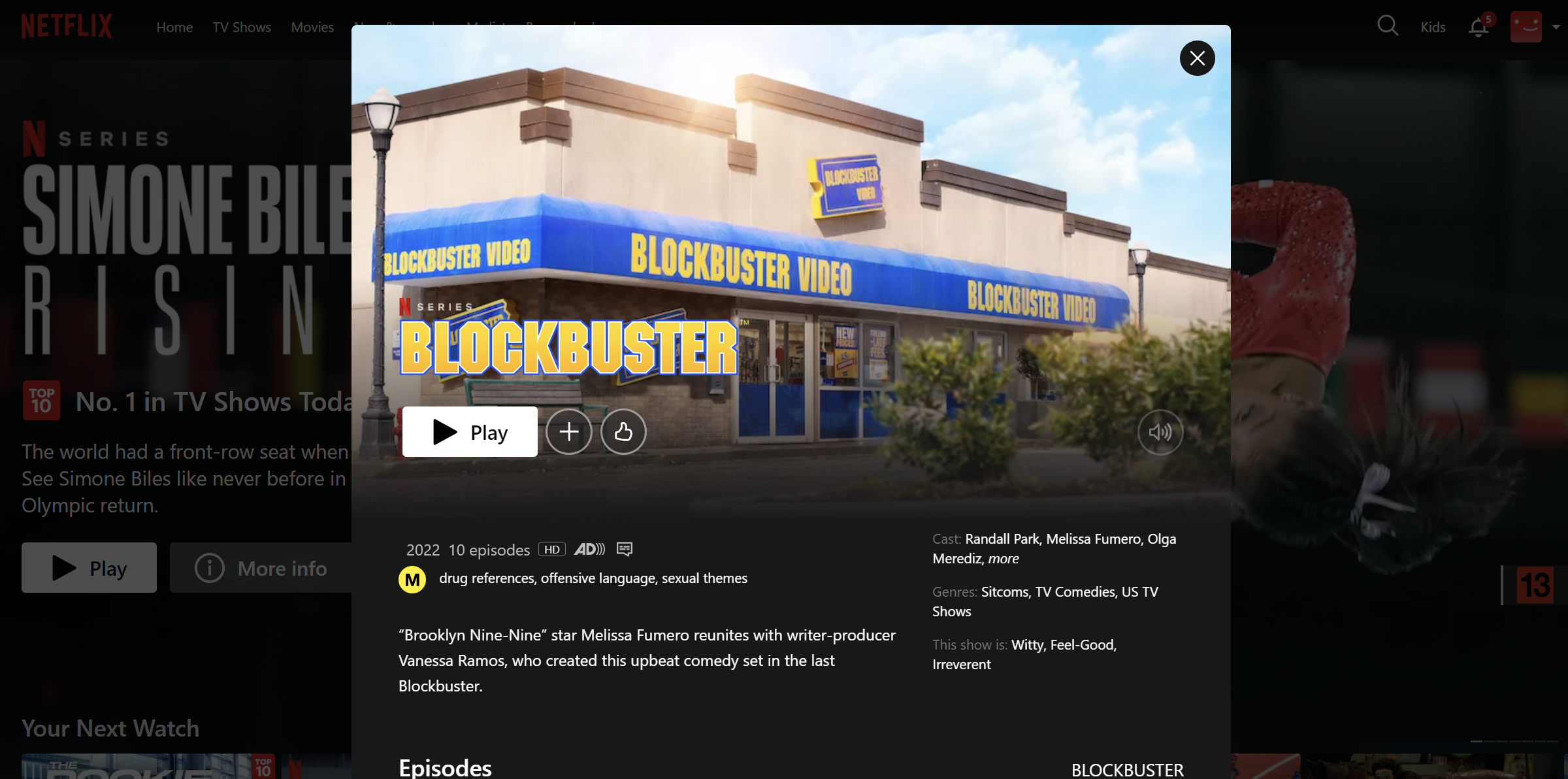
Fitting that there is now a documentary on Netflix about the last Blockbuster
Background
Blockbuster was the dominant player in video rentals throughout the 1990s and early 2000s, with thousands of physical stores across the United States. Netflix, founded in 1997, started as a DVD-by-mail rental service before transitioning to streaming in 2007.
Counter Positioning Strategy
Netflix's counter positioning strategy included:
- Subscription Model: Instead of per-rental fees, Netflix offered unlimited rentals for a flat monthly fee.
- No Late Fees: Netflix eliminated the unpopular late fees that were a significant revenue source for Blockbuster.
- Convenience: DVDs delivered directly to customers' homes, eliminating the need to visit a physical store.
- Data-Driven Recommendations: Netflix used customer data to provide personalized movie recommendations, enhancing the user experience.
- Netflix Originals: The company began producing original content, differentiating itself from traditional studios.
Why Blockbuster Couldn't Easily Respond
Blockbuster faced several challenges in responding to Netflix's model:
- Cannibalization of Existing Business: Adopting a subscription model would have cannibalized Blockbuster's lucrative late fee revenue.
- Real Estate Investments: Blockbuster had significant investments in physical stores, making it difficult to pivot to a mail-order or streaming model.
- Organizational Inertia: Blockbuster's leadership was slow to recognize the threat posed by Netflix's innovative model.
Outcome
As of 2024, Netflix has over 270 million subscribers worldwide and has expanded into original content production. Blockbuster, unable to adapt quickly enough, filed for bankruptcy in 2010 and has since become a cautionary tale in business strategy.

Tesla vs. Traditional Auto Manufacturers
Tesla's entrance into the automotive industry provides another compelling example of counter positioning against established car manufacturers.
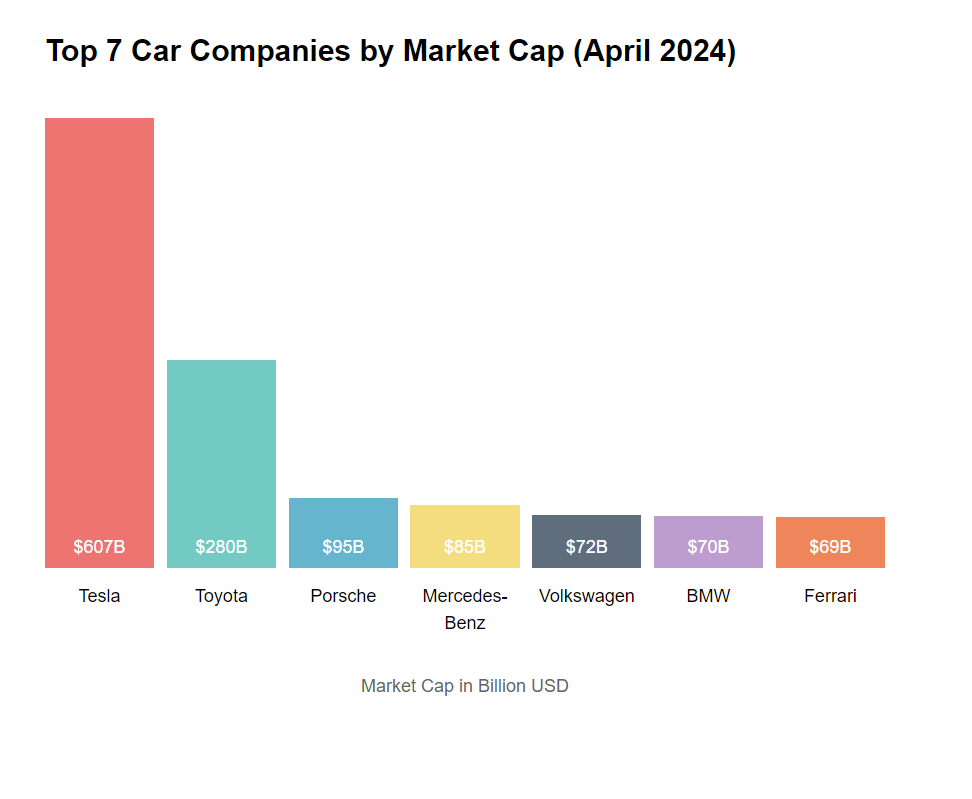
Background
Traditional auto manufacturers had been producing internal combustion engine (ICE) vehicles for over a century. Tesla, founded in 2003, entered the market with a focus solely on electric vehicles (EVs).
Counter Positioning Strategy
Tesla's counter positioning strategy included:
- All-Electric Focus: Unlike traditional manufacturers who treated EVs as a sideline, Tesla focused exclusively on electric vehicles.
- Direct Sales Model: Tesla sold directly to consumers, bypassing the traditional dealership model.
- Software-First Approach: Tesla treated its cars as software platforms, offering over-the-air updates and continuous improvements.
- Vertical Integration: Tesla produced many components in-house, including batteries, giving them greater control over the supply chain and technology.
Why Traditional Manufacturers Couldn't Easily Respond
Established auto manufacturers faced several challenges in responding to Tesla's model:
- Existing Investments: Massive investments in ICE technology and manufacturing made it difficult to pivot quickly to EVs.
- Dealer Networks: Contractual obligations and relationships with dealerships prevented them from easily adopting a direct sales model.
- Organizational Structure: Traditional manufacturers were not set up to operate like software companies, making it challenging to match Tesla's rapid innovation cycle.
Outcome
Tesla's counter positioning strategy has been highly successful. As of 2024, Tesla is the world's most valuable automaker by market capitalization, despite selling fewer cars than many traditional manufacturers.
Tesla's success has forced the entire auto industry to accelerate their transition to electric vehicles.
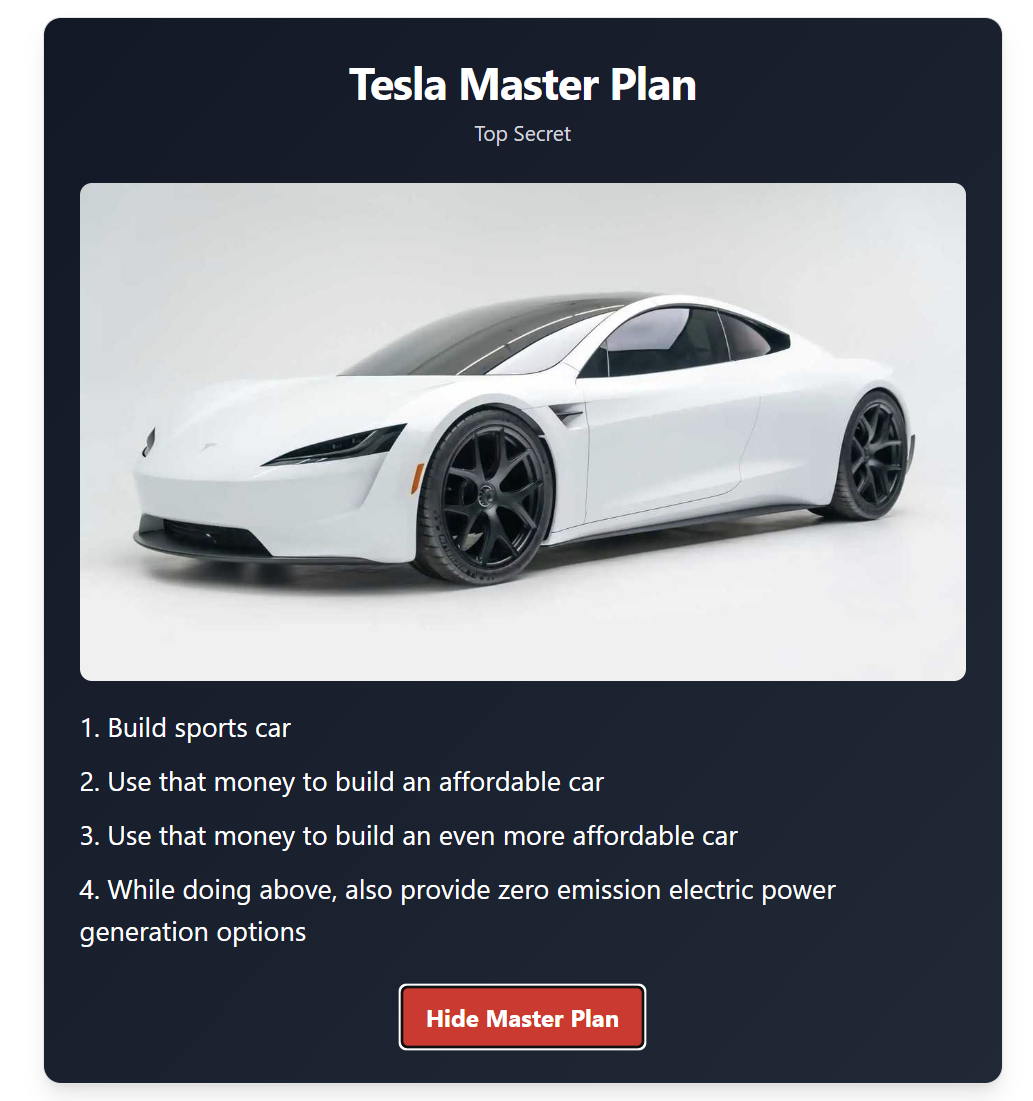
Spotify vs. Traditional Music Industry
Spotify's disruption of the music industry provides another excellent example of counter positioning.
Background
The traditional music industry model was based on selling physical albums or digital downloads. Spotify, launched in 2008, introduced a streaming model that fundamentally changed how people consume music.

Counter Positioning Strategy
Spotify's counter positioning strategy included:
- Freemium Model: Offering a free, ad-supported tier alongside a premium subscription service.
- Vast Library: Providing access to millions of songs for a monthly fee, rather than requiring individual purchases.
- Personalized Playlists: Using data analytics to create personalized playlists and recommendations for users.
- Platform for Artists: Offering tools for artists to promote their music and connect with fans directly.
Why Traditional Music Companies Couldn't Easily Respond
Established music companies faced several challenges in responding to Spotify's model:
- Existing Revenue Streams: The streaming model initially generated less revenue per listener than album sales or downloads.
- Licensing Complexities: Existing contracts with artists and labels made it difficult to quickly adapt to a streaming model.
- Technological Infrastructure: Traditional music companies lacked the technological capabilities to build and maintain a streaming platform.
Outcome
Spotify's counter positioning strategy has been highly successful. As of 2024, Spotify has over 500 million monthly active users and has become the dominant platform for music streaming.
The success of Spotify and other streaming services has forced the entire music industry to adapt to the streaming model.

Path of Exile vs. Diablo 3
The gaming industry has seen numerous examples of counter positioning, but one that stands out is the battle between Path of Exile and Diablo 3 in the action role-playing game (ARPG) genre.

The Path of Exile skill tree - a key selling point in the original days against Diablo 3
Background
Diablo 3, developed by Blizzard Entertainment, was a highly anticipated sequel in the popular Diablo franchise. It was released in 2012 with a traditional business model: a one-time purchase price for the game, followed by paid expansions.
Path of Exile, developed by Grinding Gear Games, was released in 2013 as a free-to-play ARPG. It adopted a radically different business model and game design philosophy.
Counter Positioning Strategy
Path of Exile's counter positioning strategy included:
- Free-to-Play Model: Unlike Diablo 3's upfront cost, Path of Exile was completely free to download and play.
- Ethical Microtransactions: The game monetized through cosmetic items and convenience features, avoiding "pay-to-win" elements.
- Frequent Content Updates: Path of Exile released major, free content updates every 13 weeks, keeping the game fresh and engaging.
- Complex Character Customization: The game offered a vast, intricate skill system that appealed to hardcore ARPG fans.
Why Blizzard Couldn't Easily Respond
Blizzard faced several challenges in responding to Path of Exile's model:
- Existing Revenue Model: Shifting Diablo 3 to a free-to-play model would have disrupted their existing revenue stream from game sales and expansions.
- Brand Expectations: Blizzard's reputation for polished, premium games made it difficult to adopt a free-to-play model without risking brand damage.
- Development Pipeline: Blizzard's longer development cycles made it challenging to match Path of Exile's frequent content updates.
One of the things that Hamilton Helmer describes in the book when you are under attack by counter positioning is that you constantly feel like you are losing. This article talking about the Billzard developers gives a good inside look as to what it feels like when this happens.
Outcome
The game has grown to over 20 million registered players and has maintained a strong, dedicated community. While Diablo 3 was commercially successful, it faced criticism for its initial design choices and monetization strategy.
Path of Exile's success ultimately influenced the development of Diablo 4, which has adopted some elements of the "games as a service" model.
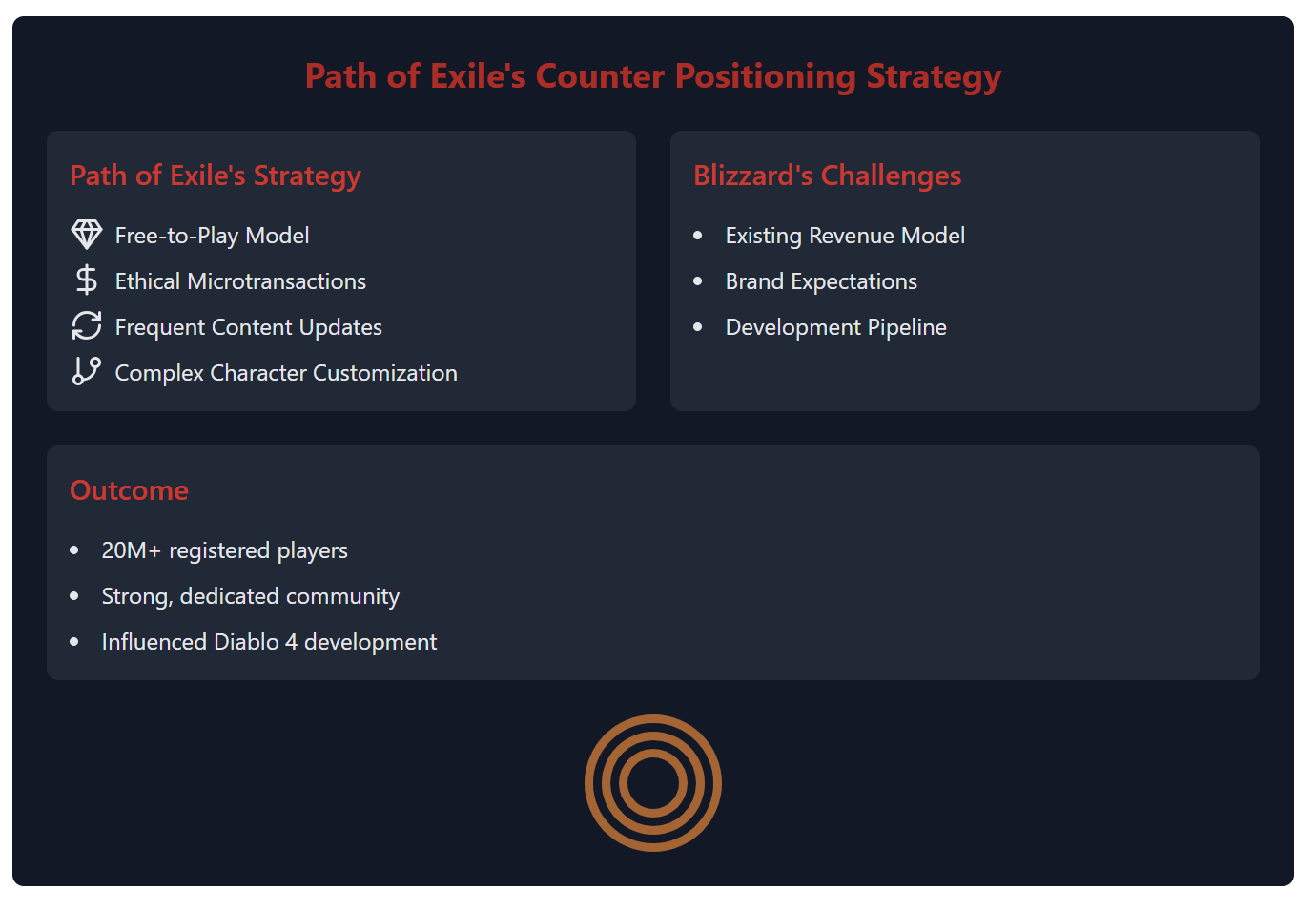
Amazon Web Services vs. Traditional IT Infrastructure
Amazon Web Services (AWS) provides our final example of successful counter positioning against traditional IT infrastructure providers.
Background
Traditionally, companies had to invest heavily in their own IT infrastructure, including servers, data centers, and networking equipment.
Amazon launched AWS in 2006, offering cloud computing services that allowed companies to rent computing resources on-demand.
Counter Positioning Strategy
AWS's counter positioning strategy included:
- Pay-As-You-Go Model: Offering computing resources on-demand with no upfront costs or long-term commitments.
- Scalability: Providing the ability to quickly scale resources up or down based on demand.
- Wide Range of Services: Offering a comprehensive suite of cloud services beyond just computing power.
- Continuous Innovation: Rapidly introducing new services and features to meet evolving customer needs.
Why Traditional IT Providers Couldn't Easily Respond
Established IT infrastructure providers faced several challenges in responding to AWS's model:
- Existing Business Model: The shift to cloud services would cannibalize their lucrative hardware sales and long-term service contracts.
- Organizational Structure: Traditional IT companies were not set up to operate as service providers, making it difficult to match AWS's agility.
- Investment in Physical Infrastructure: Significant investments in manufacturing facilities and supply chains for hardware made it challenging to pivot to a service-based model.
Outcome
As of 2024, AWS is the leading cloud service provider, with a market share of over 30% and annual revenue exceeding $80 billion.
The success of AWS has forced the entire IT industry to shift towards cloud-based services and has spawned numerous competitors attempting to capture a share of the growing cloud market.

Conclusion
These five examples demonstrate the power of counter positioning as a strategy for disrupting established industries and gaining a competitive advantage.
From gaming to entertainment, automotive to music, and IT infrastructure, innovative companies have used counter positioning to challenge incumbents and reshape entire markets.
Key takeaways from these examples include:
- Identifying Industry Pain Points: Successful counter positioning often involves addressing major pain points or inefficiencies in existing industry models.
- Leveraging New Technologies: Many of these disruptors used emerging technologies to enable new business models that incumbents struggled to replicate.
- Focus on Customer Experience: A common thread among these examples is a relentless focus on improving the customer experience.
- Willingness to Cannibalize: Disruptors were often willing to cannibalize potential revenue streams to offer a superior product or service.
- Long-Term Vision: Successful counter positioning requires a long-term vision and the patience to see it through, often in the face of initial skepticism or resistance.
"Innovation distinguishes between a leader and a follower." - Steve Jobs
The book that keeps on giving
7 powers is an interesting book. It wins the award for changing my thinking the most. It also wins the award for book that I love but can understand why you might not.
I've been observing origination stories and in particular I have been on the lookout for counter positioning being present in the story. You know how when you buy a car and then you see that car everywhere?
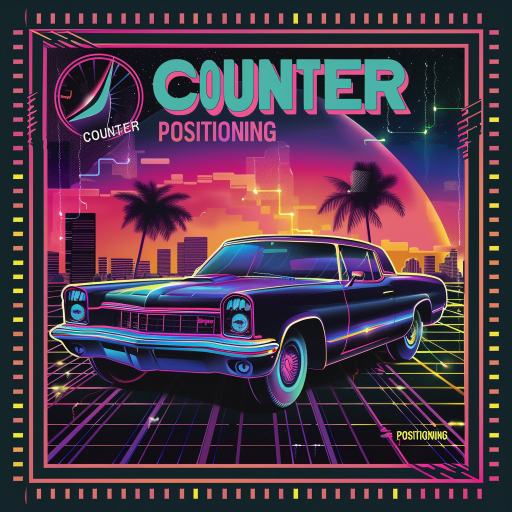
That's me with counter positioning.